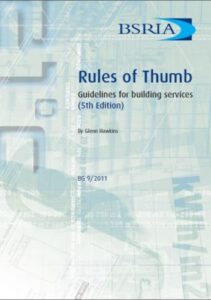Rules of Thumb – Guidelines for building services 5th Edition
Rules of Thumb – Guidelines for building services 5th Edition
Rules of Thumb – Guidelines for building services 5th Edition are general principles derived from practice and experience rather than precise theory. The 5th edition of Rules of Thumb has been created by referencing various contemporary sources in the building services industry and can reasonably be held to reflect current design practices. The guide is useful for approximately calculating values, setting outline targets and rapidly comparing different options to inform the early stages of the design process.
You can also Read Design Checks for HVAC A quality control framework
This popular publication has been updated and expanded to include more detailed information and now comes in a more user-friendly spiral-bound format. The new additions include:
- Greatly increased guidance about space and weight allowances
- CO2 emissions benchmarks
- Clearer guidance about costs, expanded to include energy consumption, maintenance, operation and life cycle cost information
- A system features section subdivided into mechanical and electrical systems and clarified
- Guidance about compliance with Part L of the Building Regulations, renewable technologies and air permeability of buildings.
Rules of Thumb – Guidelines for building services 5th Edition Content
- Space and Weight Allowances
![Guidelines for building services]()
- System Features – Mechanical Building Services
- The System Features – Electrical Building Services
- System Features – natural Ventilation
- Cooling and heating loads
- Electrical Loads
- Water Consumption
- Internal and External design Criteria
- Energy and carbon
- Costs
- Glossary of terms
- international System of units
- Conversation factors
- Index
- References
Whatever the application, a Rule of Thumb considered as a general principle or means of estimation derived from practice and experience, rather than precise theory. It represents a method for broad application that not intended accurate for every situation. However, a Rule of Thumb easily learned and applied, which means that extremely useful for approximately calculating a value, setting outline targets or rapidly comparing different options.


Comments are closed.